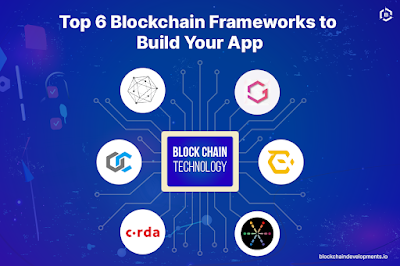Blockchain has proven itself as a valuable technology and can be utilized almost everywhere. In every sphere; the craze of blockchain-based applications is increasing. It doesn't matter whatever the sphere is, whether it is commerce, finance, agriculture, government, or healthcare, you have to learn to work with blockchain swiftly.
But to do it correctly, you need to pick up the right blockchain solutions and frameworks that fit your purpose. We, Blockchain, are a promising blockchain development company in USA that provides services around the world. The top 6 Blockchain frameworks that you may use to build an app are given below.
Hyperledger:
Hyperledger is also an open-source code and does not support cryptocurrency, just like Exonum. It was made as an arena where individual developers and different communities can hold meetings and cooperate for working on technologies associated with blockchain. This cooperation resulted in the development of popular blockchain tools to build healthcare, IoT, financial, banking, and several other related projects.
The members fund the project of Hyperledger, and an "umbrella strategy" is used. It means that the project of Hyperledger is not a single tool and rather is a bunch of instruments, interfaces, frameworks, and libraries. Hyperledger Sawtooth, Hyperledger Iroha, Hyperledger Fabric, and Hyper Burrow are popular examples of Hyperledger blockchain technology.
Hyperledger framework is flexible, modifiable, maintainable, and scalable. The wide number of ready-to-use tools and solutions enables the developers to make apps with a well-prepared architecture and clean code.
Corda:
Among the popular blockchain technology frameworks, Corda is an open-source technology that reduces the record-keeping and transaction cost of the businesses and streamlines the operations of the business.
It helps to manage, store, synchronize, and control financial obligations between separate organizations, and also takes care of privacy. The participants who have access to the system can only confirm the transactions. It does not have an internal currency and offers you several consensus algorithms.
Graphene:
Graphene is written in C++ mostly, and its modular structure makes it adaptable for blockchain technology development. Currently, this framework offers several financial services. Graphene is chosen because of its reliability and transparency.
It has the capability for processing up to 3000 transactions every second and is thus helpful for the continuous operations of large financial and economic companies. It forms a new block in just three seconds, permits working with several tokens in a single system, and also supports payment with no commission.
Openchain:
Openchain is designed for managing and issuing digital assets. However, the primary aim of this blockchain framework is to fulfill the wants of financial institutions and banks. It allows the financial institutions to manage all the financial processes effectively and improve the anti-money and anti-fraud laundering systems.
If you want to optimize the infrastructure of your organization and make it adaptable to various needs, the Openchain framework is the ideal choice. This framework depends on a partitioned and consensus algorithm where each instance has a single authority having the power of validating transactions.
This develops a client-server type of architecture that is more trustable compared to the peer-to-peer type of architecture. All the tokens and Bitcoin can be connected or linked, and the framework depends on modules having a smart contract. It contains a uniformed API and allows the developers to make several blockchains. And the developers get full control over the infrastructure with the correct transparency.
Exonum:
Exonum is an open-source code like the APIs (Application Programming Interfaces). Besides providing access to the whole database, but to client software as well for managing blockchain. Exonum does not require to stay dependent on any cryptocurrency as it is independent.
It has the potential to process about 5,000 transactions per second, and this is fast. The light client of Exonum can check the user data’s correctness, availability, and anchorage status, according to the blockchain technology solutions. Moreover, this framework avoids the chance of all sorts of document forgery and double-entry bookkeeping.
MultiChain:
Another highly customizable and configurable framework is MultiChain. It can be applied to create and launch a blockchain privately for an organization or company. It has all the required access and privacy levels and also has a command-line interface besides a simple API that makes it easy to use. Moreover, it also supports most of the server OS.
As this framework is made on the principle of mining, it offers the necessary privacy. And as the block sizes can be managed by the participants, scaling becomes seamless. The private keys allow the participants to have overall control over the assets.
This blockchain is decentralized and is reliable as it does not depend on any particular server. Thus, in case even if the server gets shattered, it will not impact the processing of the transactions for a blockchain development company in USA.
Conclusion:
Blockchain frameworks allow developers to operate more efficiently and faster. All the mentioned blockchain frameworks are open-source, support smart contract functionality, or are analog. However, the other features may vary. Thus, try to start with a framework that has developer support and a powerful community.




0 Comments